HP w2408: A "New" Twist on 24" LCDs
by Jarred Walton on December 21, 2007 5:00 AM EST- Posted in
- Displays
Printing
Results
Brightness and Contrast Ratio
For those who have a need to match colors between their computer displays, cameras, and printers, what works well for computing purposes often isn't the best suited for doing other image related work. To help people who work in such areas match their computer colors to their paper colors better, standards were established. For print work, the standard is a gamma of 2.2, a black point of 0.60 nits, and a white point of 100 nits. We attempt to calibrate all the monitors for these settings.
Finding the appropriate settings to reach these levels can be a time-consuming process for some of the displays. It may require numerous iterations through the calibration process to end up with the desired white point, and on some LCDs it might not even be possible to reach a satisfactory result (though that hasn't occurred yet). The nature of LCDs is such that we are unable to get both an accurate white point and an accurate black point according to printing requirements (our black levels always ended up darker than they are supposed to be), but we did manage to get near the desired 100 nits white point on all of the tested displays. We used brightness/contrast settings of 42/80 on the w2408, with RGB at 169/162/175.
For reference, we have included the target value in the following graphs, so the greater the deviance of a display from the targeted value, the less suitable (in theory) a display becomes for print work.
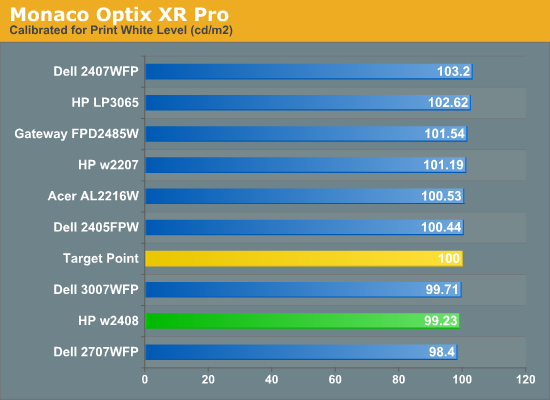
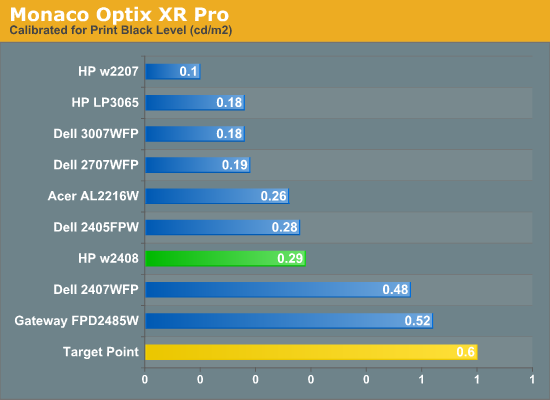
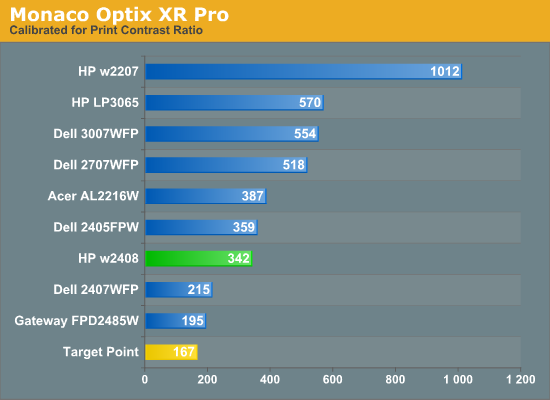
Since very slight differences in brightness are not a huge deal, we did not attempt to get 100% accuracy on the white point, but further tuning of the various displays would have made it possible to get closer to 100 nits. The primary goal was to get the white point near 100 nits. The target black point is nearly impossible to achieve once we have reached the target white point with any LCD that we have used. Due to the reduced brightness, contrast ratios are often lower, but that is inherent with the target settings. Interesting to note, we get higher black levels on many of the 24" LCDs than on other options when attempting to calibrate for print. The HP w2408 ranks third in terms of closeness to the print ideal.
Color Accuracy
Given the importance of accurate colors for printing work, we need to adjust the desired Delta E scale. A Delta E of less than 1.0 is definitely the goal here, and 1.0 to 2.0 is merely acceptable. Scores above 2.0 generally mean a display is not fit for printing professionals.
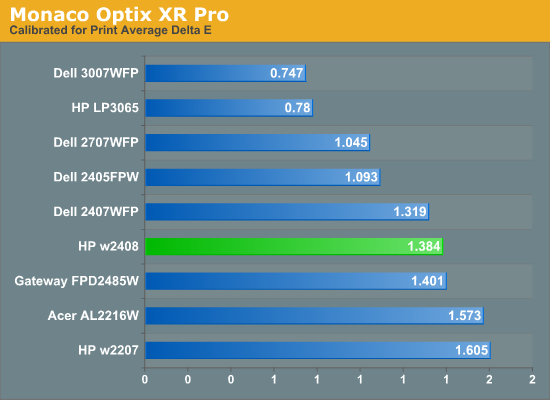
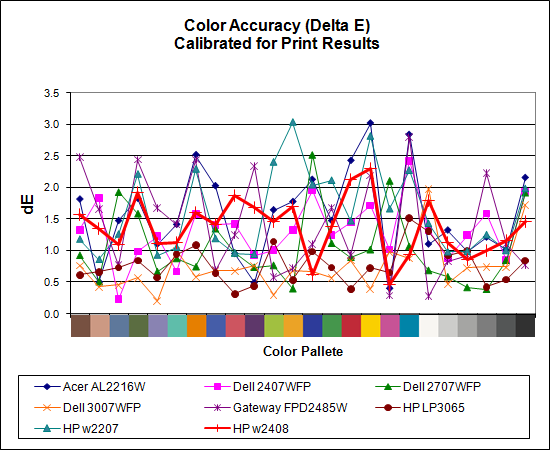
The two 30" displays clearly take the lead in this test, while the w2408 falls in the middle of the pack. Most of the scores fall below 2.0, which is better than the w2207. If you want 100/0.60 white/black settings for print work, this is one of the better options, though the Gateway FPD2485w and Dell 2407WFP still rated better.










30 Comments
View All Comments
JarredWalton - Sunday, December 23, 2007 - link
It's partly an issue of getting enough reviews done so that more manufacturers are willing to work with us on monitor reviews. Things take time, and sometimes we go through periods where nothing new comes out for a while. I've got at least a few more LCDs coming shortly, and I hope many more post-CES will get sent our way for review.GlassHouse69 - Saturday, December 22, 2007 - link
IPS panels are the best for all things. some s-pva or mva's are close competitors to ips but still have colour errors and colour washout on angles over 20 degrees from center.tn panels shouldnt be priced higher than 350 dollars. one could get an almost 0 lag (15-19ms) 24" s-pva panel from LG and be more pleased for gaming and general use for 500 dollars.
i paid a grand for my 26" 1920x1200 H-IPS panel from planar. it is incredibly clear and accurate and has less than 1 frame lag. spending 550 dollars on a tn panel vs 900 dollars on a IPS pro fessional panel... sux cant see the point/value.
nevbie - Saturday, December 22, 2007 - link
Have you lurked in the xtknight's LCD thread at the forums?Perhaps you might get ideas about what people seek from reviews and what kind of LCDs they seek.
For me it seems that there are more interesting LCD models out there than reviews of LCDs. Pretty much the opposite situation when compared to GPUs or other less subjective review targets.
Anandtech LCD reviews seem a bit bare for me, as there are less measurements than in some other LCD review sites. It is difficult to say if reviewers at the other sites measure things that I would notice though, or if the extra measurements just generate artificial desires. Input lag measurements at behardware or RTC error measurements at xbitlabs are interesting, for example, but I don't know if I would be bothered by less than ideal results in actual use.
PS. The old comment system was better - no need to load/reload the article page when browsing comments.
9nails - Saturday, December 22, 2007 - link
What is "TN"?How about "S-PVA"?
Bonus question: How do the two differ / which is better?
JarredWalton - Saturday, December 22, 2007 - link
Well, I could try to explain it, but wikipedia already has a good deal of data on the matter. http://en.wikipedia.org/wiki/Thin_film_transistor_...">This Film TransistorsThe simple answer is that in my opinion:
S-IPS > S-PVA > S-TN/TN+Film
TN panels often have lower stated response times, but frankly I can't see the difference. I can however see the difference between the two in viewing angles and color quality.
trajan - Saturday, December 22, 2007 - link
I know it should go without saying (and usually does) but thanks for another great review that is so clearly unbiased. Just seems to me that if Anandtech is having a hard time getting manufacturers to send LCDs for review, handing out a negative article on the first offering is probably not going to encourage other manufacturers to follow suite. But the truth is the truth, and particularly after recent high profile events on other sites its nice to get a little reminder of the quality we can enjoy here.(This probably is coming across all doe-eyed fanboyish.. meh. It's just really nice to have trust worthy info sources)
KorruptioN - Friday, December 21, 2007 - link
The LG L246WP-BN is a P-MVA panel... it's beautiful and doesn't seem to exhibit some of the colour shifting that some PVA panels do. It'll be either that or Dell's next 24" for my next LCD.gochichi - Monday, December 24, 2007 - link
I recommend it at the $450.00 price tag. I own this display and I am very pleased with it overall. I vastly prefer the HDMI/DVI input as opposed to VGA on this particular display (some displays you literally can't tell the difference, not so on this panel).It is WORLDS better than the cheapish 24" Samsung. Samsung is building an overinflated name for itself... that or they are seriously risking their brand name over some "too good to be true" products (they really aren't good when you get them home).
I more than ever depend on review sites and user comments to help me navigate the sea of available products. I personally believe that the Dell is superior to the LG 24", however, the LG is more readily available at retail stores and a fantastic deal at $449.00.
agull22 - Friday, December 21, 2007 - link
I would like to see how HP plans to really markey this screen costing what it does and doing so litle for its return really. Right now though I am using my HP 42" Plasma as a monitor. I can honestly say it looks much nicer than the LCD equivalent. It would be nice to see something between the 42 and 26 size range though.LoneWolf15 - Friday, December 21, 2007 - link
$570? I paid around that price a year ago for a Dell 2407. I got an S-PVA panel, additional inputs (component, s-video), 9-in-1 card reader, 4 USB ports, and I got the five-year warranty.If HP thinks they can sell that panel for $570, they need to think again. 6-bit color, poorer viewing angle, limited inputs --you can do better for your money.